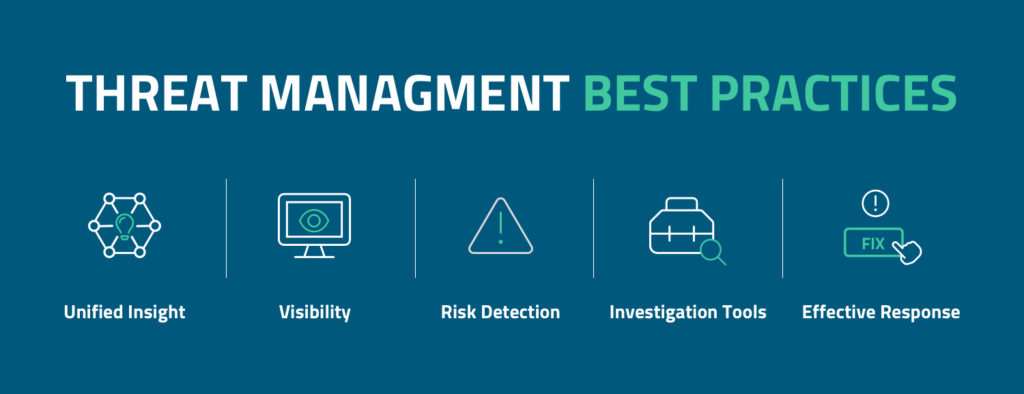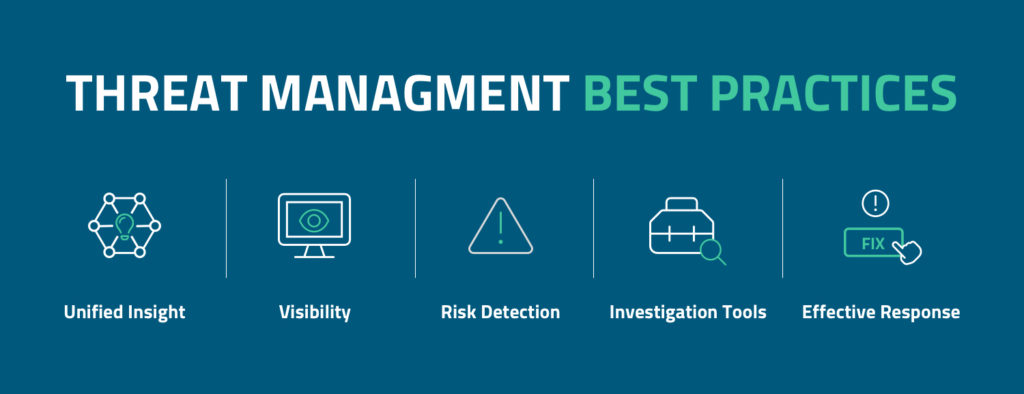
Threat management is a process that is used by cybersecurity analysts, incident responders and threat hunters to prevent cyberattacks, detect cyberthreats and respond to security incidents.
Why is threat management important?
Most IT and security teams face information fragmentation, which can lead to blind spots in security operations teams. And wherever they exist, blind spots compromise a team’s ability to identify, protect, detect and respond to security threats at the speed of Zero-Day attacks.
Today’s dangers now include AI/ML powered mutating software, advanced persistent threats (APT), insider threats, and vulnerabilities focused on on premises, IoT/OT and cloud computing services and hosted software as a service far more than— more than legacy antivirus software can handle. With the ever-disappearing perimeter of protected IT infrastructure and today’s remote workforce, enterprises constantly face new complex risks and security threats 24/7.
Let’s begin with an overview of the critical nature of threat management in today’s digital landscape. Then we will highlight the increasing complexity and frequency of cyber threats that organizations face.
Importance of Threat management
Threat management is a critical component of modern cybersecurity strategies, encompassing the identification, assessment, and response to cyber threats to protect information, assets, and networks. The importance of threat management stems from its role in safeguarding an organization’s digital infrastructure against the ever-evolving landscape of cyber threats. Below are key reasons why threat management is indispensable for organizations of all sizes and verticals:
- Protection Against a Wide Range of Threats:
Threat management involves defending against a variety of cyber threats including malware, ransomware, phishing attacks, insider threats, behavioral anomalies, and advanced persistent threats (APTs). By implementing a robust threat management strategy, organizations can protect themselves against both known and emerging threats, ensuring the integrity, confidentiality, and availability of their data.
- Minimizing Financial and Operational Impact:
Cyber incidents can result in significant financial losses due to system downtime, data breaches, legal fees, forensics, reporting, and more. Effective threat management minimizes the risk of such incidents, thereby protecting the organization from potential financial and operational disruptions. By detecting and responding to threats swiftly, organizations can reduce the severity of attacks and avoid costly downtimes.
- Ensuring Compliance and Protecting Reputation:
Many industries are subject to regulatory requirements that mandate certain levels of cybersecurity measures, including effective threat management practices. Failure to comply can result in hefty fines and legal penalties. Additionally, a successful attack can severely damage an organization’s reputation, eroding customer trust. Effective threat management helps ensure compliance with regulatory standards (such as PCI-DSS, HIPAA, CMMC, NIST 2.0, NIS2) and protects the organization’s reputation by maintaining the security of sensitive data.
- Enhancing Strategic Decision-Making:
Threat management provides valuable insights into the threat landscape and the organization’s security posture. This information is crucial for making informed strategic decisions regarding security investments in software; people, threat intelligence feeds, and policies and more. By understanding the nature and frequency of attacks, organizations can allocate resources more effectively and develop strategies that address their most significant vulnerabilities.
- Supporting Business Continuity and Resilience:
In the face of a cyberattack, maintaining operational continuity is paramount. Threat management plays a vital role in business continuity planning by identifying potential threats to critical systems and processes, and by developing strategies to mitigate those threats. This ensures that the organization can continue to operate and recover quickly from an attack, thereby minimizing the impact on business operations.
- Facilitating a Culture of Security:
A comprehensive threat management program raises awareness about cybersecurity across the organization, fostering a strong security culture. When employees understand the potential threats and the importance of adhering to security policies, they become an active part of the organization’s defense mechanism. This collective vigilance significantly enhances the overall security posture.
How does threat management work?
Threat management is a comprehensive approach encompassing various processes and technologies to protect an organization’s data, systems, and networks from cyber threats. It involves the identification, assessment, prioritization, and response to threats, aiming to minimize the impact of potential security incidents. Here’s an overview of how threat management works:
- Threat Identification
The first step in threat management is identifying potential threats. This involves gathering and analyzing data from various sources to detect activities that could indicate a threat. Sources include network traffic, logs from firewalls and endpoint protection systems, threat intelligence feeds, and more. Advanced legacy tools and technologies like intrusion detection systems (IDS), security information and event management (SIEM) systems, and now machine learning (ML) and artificial intelligence (AI) can automate the detection process, identifying known threats and unusual patterns that could indicate new or emerging threats. Unlike human-only driven “store and query” approaches, today’s modern SIEM’s possess the ability to track the attacks over time and correlate indicators of compromise and indicators of behaviors at scale.
- Threat Analysis
Once potential threats are identified, they must be analyzed to understand their nature, origin, and potential impact. This analysis helps differentiate false positives from genuine threats and provides insights into the tactics, techniques, and procedures (TTPs) used by attackers. Often that involves mapping them to the MITRE ATT&CK framework. Threat analysis involves examining the threat’s behavior, the systems or data targeted, and any vulnerabilities being exploited. This step is crucial for prioritizing threats based on their severity and potential damage.
- Threat Prioritization
Not all threats pose the same level of risk to an organization. Threat prioritization involves assessing the severity of identified threats and ranking them based on factors such as their potential impact on critical systems, the likelihood of exploitation, and the sensitivity of the data at risk. This prioritization enables organizations to allocate their resources and efforts effectively, focusing on mitigating the most critical threats first.
- Threat Response
Once threats have been prioritized, the next step is to respond to them appropriately. The response can vary depending on the nature and severity of the threat and may include measures such as patching vulnerabilities, isolating affected systems, removing malware, and updating security policies and controls. Incident response teams may be deployed to manage the situation, containing the threat, eradicating the cause, and recovering any affected systems or data. Even more interesting is that today’s modern SIEM and SOAR capabilities are powered by AI/ML to respond 24/7 in an automated way to contain, block and stop threats from causing damage or data exfiltration.
- Post-Incident Analysis
After a threat has been managed, it’s important to conduct a post-incident analysis to understand what happened, how it was handled, and what can be done to prevent similar incidents in the future. This involves reviewing the effectiveness of the response, identifying any gaps in the organization’s security posture, and updating threat management processes and security measures accordingly.
- Continuous Monitoring and Improvement
Threat management is an ongoing process. Organizations must continuously monitor their networks and systems for new threats, reassess their security measures, and update their threat management practices based on evolving cyber threats and changing business needs. This includes staying informed about the latest cyber threats and trends, updating threat intelligence, and continuously training staff on security awareness and best practices.
I’d be remiss if I did not introduce Seceon as a leading provider of real-time automated detection and response built on a foundation of threat management.
Seceon’s powerful AI/ML-powered aiSIEM, aiXDR, and aiSIEM-CGuard solutions operate in real-time and perform efficient automated detection and response. Seceon’s comprehensive threat intelligence and vulnerability analysis foundation enables a strong program for threat management.
Let’s briefly look at how Seceon uses cutting-edge technologies such as AI and ML for real-time threat detection and response. Highlight key features of Seceon’s solutions, such as:
- Real-Time Detection: Using advanced analytics to identify threats as they occur.
- Automated Response: Mechanisms that enable the immediate neutralization of threats without manual intervention.
- Comprehensive Visibility: The platform offers a holistic view of the network, enabling organizations to identify vulnerabilities and potential threats.
The benefits of Seceon’s platform and its foundation of threat management illustrate the advantages of deploying Seceon’s unified platform includes:
- Enhanced Security Posture: Strengthened defenses against a wide array of cyber threats.
- Reduced Incident Response Time: Faster mean time to detection and mean time to response to incidents, (MTTR, MTTD) minimizing potential damage.
- Compliance and Risk Management: Helping organizations meet regulatory compliance requirements and manage risks more effectively.
- Cost-Effectiveness: Reducing the financial impact of cyber incidents through proactive threat management.
Read some of our case studies from among our 7,800+ global organizations that benefit from Seceon’s platform.
如有侵权请联系:admin#unsafe.sh
